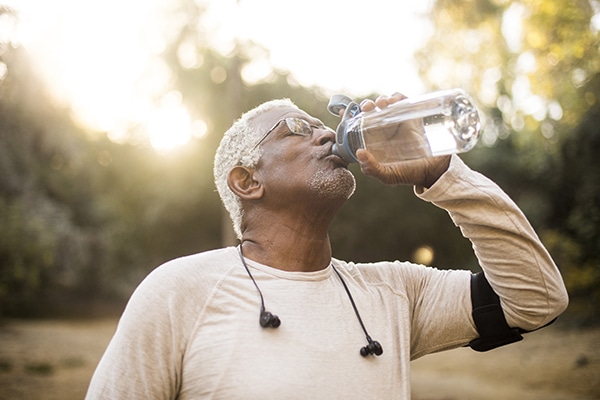How to Avoid a Kidney Stone in 2024
January 27, 2024

Thirsty? Be sure to say ‘yes’ to that tall glass of water. It may save you from searing pain in the near future.
If your body is dehydrated, it is less likely to produce enough urine to carry out salts, calcium, and uric acid from your kidneys. In time, these minerals can form into stones, which can result in blood in the urine, pain on the side and back, and a frequent urge to urinate.
Often, stones aren’t even detectable – unless they reach a certain size and then move into the ureter (the tube between the kidney and the bladder). If this happens, a stone can block urine from passing as it should. Instead urine is forced back into the kidney. And ouch, then you know.
In general, one in 10 people experience kidney stones at some point in their lives. And the winter months can trigger them for two reasons:
- Your body might produce more calcium in urine during the winter months, research shows, and most kidney stones – nearly 80%, according to the Cleveland Clinic – are calcium-based. A high balance of calcium in urine therefore increases the likelihood of stones.
- We tend to be less active in the winter which makes stones more likely to develop.
You’ll know you have a kidney stone once it starts moving because the pain it causes can be excruciating.
Tips for Skipping Stones
The easiest step to preventing stones from developing is drinking lots of non-sugary fluids, which will help carry stone-contributing minerals out of the body. We suggest no less than nine glasses a day for women, and 13 for men. If sweating a lot, up those numbers.
Here are a few other precautionary steps:
- Shake off the salt. Sodium increases the amount of calcium in urine. Think twice before eating high-sodium processed foods, fast foods, and salty snacks.
- Cut down on animal portions. Too much red meat, poultry, eggs, and seafood can cause stone-friendly uric acid levels to climb.
- But do get some calcium. It sounds counterintuitive, but if there is too little calcium in the diet, certain acid levels will rise and the salts from these acids (oxalates) will contribute to stone formation.
- Limit certain foods. Some foods, including chocolate, beets, spinach, rhubarb, tea, and many nuts, carry high levels of oxalates. Phosphates, too, are stone culprits (think colas). Regulate these foods and pair them with water.
How to Know if You Have a Stone
The most common sign of a kidney stone is pain from the back, sides, groin, and/or testicles (for men). The pain can be sharp enough to cause nausea and vomiting, and there may be blood in the urine. Someone experiencing these symptoms should see a urologist.
The good news is that small kidney stones may be able to pass through the body naturally within days or weeks of formation, with the help of lots of water. A doctor will be able to provide guidance.
However, if a stone causes complications, such as an infection or blockage, it will have to be removed. The physicians at MidLantic Urology offer several options for stone removal, depending on the size, type, and location. Find a urologist close to you.

